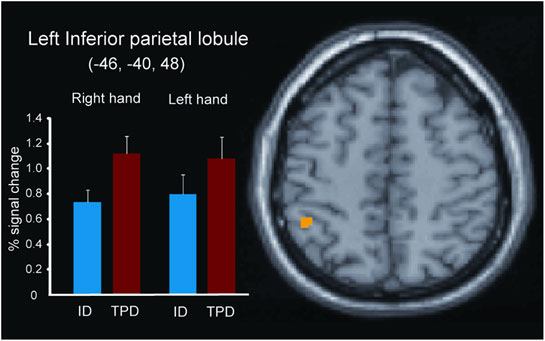Akatsuka K, Noguchi Y, Harada T, Sadato N, Kakigi R: Neural codes for somatosensory two-point discrimination in inferior parietal lobule: An fMRI study. Neuroimage, 40(2):852-858, 2008.
This is the first functional magnetic resonance imaging (fMRI) study to investigate the hemodynamic response related to somatosensory spatial discrimination, so-called two-point discrimination. During scanning, we examined two discrimination tasks using four types of electrical stimuli applied to one or two points with strong or weak intensity on the right and left forearm, respectively. In the two-point discrimination task (TPD), subjects reported whether they thought the stimulus was applied to one point or two. In the intensity discrimination task (ID), subjects were required to judge whether the stimulus was strong or weak. In each task, they pressed a button to report their choice. Comparing TPD with the control, we found activated regions in the inferior parietal lobule (IPL) around the supramarginal gyrus (SMG) (Brodmann's area 40) and anterior cingulate cortex (ACC). These areas were significantly activated irrespective of the forearm stimulated. Comparing ID with the control, there were no significantly activated regions. By comparing the TPD and ID, we identified that the left IPL was significantly activated, specifically in TPD, irrespective of the forearm stimulated. In contrast, there were no significantly activated regions in the ID task. Therefore, the left IPL is considered to play an important role in two-point discrimination.
